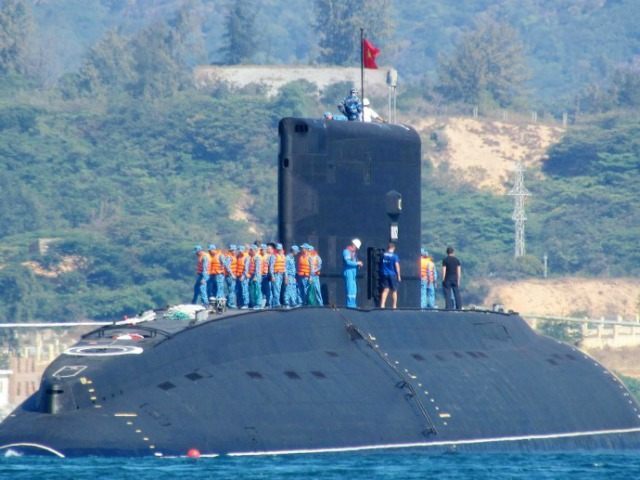Vietnam is preparing to deploy the first of six Kilo-class submarines purchased from Russia into the South China Sea, as a deterrent to China’s seemingly endless expansionism in the region.
The Sydney Morning Herald reports that at least one of the submarines has “begun patrolling disputed waters of the South China Sea, as deterrents to China’s 10 times-bigger navy,” citing Vietnamese officials. Vietnam has only received fix of the submarines from Russia so far, the sixth scheduled to arrive in early 2016. The news of a Vietnamese buildup in the Cam Ranh Bay, where all six submarines are scheduled to make their home, comes at the tail end of a week in which China has made at least three landings on manmade islands in the Spratly archipelago, prompting severe criticism from Vietnam and the Philippines. Both contest the Spratly Islands, while China claims most of the South China Sea to be its sovereign territory.
The most recent China provocation occurred on Wednesday, when state outlet Xinhua announced that two planes had landed on an artificial island on the Fiery Cross Reef, territory the international community does not deem to be Chinese. “This is a serious violation of Vietnam’s sovereignty, threatening peace and regional stability, threatening security, safety and freedom of navigation and aviation in the East Sea,” Foreign Ministry spokesman Le Hai Binh told reporters following the publication of the report.
Carlyle Thayer, a professor from Australia’s Defence Force Academy in Canberra, is quoted by The Sydney Morning Herald as saying the submarines may pose a significant problem for China as it continues to construct landing strips and other military facilities in the region. Thayer wrote of the issue:
These weapons systems should enable Vietnam to make it extremely costly for China to conduct maritime operations within a 200 to 300-nautical-mile band of water along Vietnam’s coast, from the Vietnam-China border in the north-east to around Da Nang in central Vietnam, if not further south.
This has appeared to be Vietnam’s objective since last year, when the government signed a contract with Russia to purchase new submarines. At the time, Reuters wrote that the Vietnamese military had begun emphasizing “high combat readiness” – implicitly against China – and that some military officials were concerned that military conflict with China was unavoidable. “We don’t want to have a conflict with China and we must put faith in our policy of diplomacy, but we know we must be ready for the worst,” one senior official told the news outlet.
The government of the Philippines has also sounded the alarm on Chinese activity in the South China Sea. “We are very concerned about the fact that China had already flown their flights to Fiery Cross Reef,” Albert del Rosario, Filipino’s foreign secretary, said Thursday, warning that China may eventually “take a position that an air defence identification zone could be imposed.”
An Air Defense Identification Zone (ADIZ) requires any non-Chinese aircraft to identify itself while flying through the territory in question or face military attack. China imposed such a zone in the East China Sea in 2013 in sovereign Japanese territory, though it has ceased enforcing it following a U.S. declaration that any military action against Japanese aircraft will be met with a swift American response, as the United States is bound by treaty to defend Japan.
As international concern develops around how Vietnam may use its new fleet of submarines, a new report from a Filipino protest group that traversed the disputed territory in the Spratly Islands suggests China is building its own submarine harbor on Mischief Reef in the archipelago. The Kalayaan Atin Ito (KAI) movement said in a statement Wednesday:
Palawan is just 135 nautical miles away from the Panganiban Reef, which is being developed by China into a submarine harbor. … This evil project does not concern the Filipino alone but the entire humanity, including the peace-loving Chinese people.
Members of KAI visited the region in the last week of December as a “freedom mission” to protect Filipino sovereignty from China.

COMMENTS
Please let us know if you're having issues with commenting.